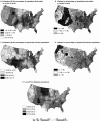Spatial analysis and correlates of county-level diabetes prevalence, 2009-2010
- PMID: 25611797
- PMCID: PMC4303405
- DOI: 10.5888/pcd12.140404
Spatial analysis and correlates of county-level diabetes prevalence, 2009-2010
Abstract
Introduction: Information on the relationship between diabetes prevalence and built environment attributes could allow public health programs to better target populations at risk for diabetes. This study sought to determine the spatial prevalence of diabetes in the United States and how this distribution is associated with the geography of common diabetes correlates.
Methods: Data from the Centers for Disease Control and Prevention and the US Census Bureau were integrated to perform geographically weighted regression at the county level on the following variables: percentage nonwhite population, percentage Hispanic population, education level, percentage unemployed, percentage living below the federal poverty level, population density, percentage obese, percentage physically inactive, percentage population that cycles or walks to work, and percentage neighborhood food deserts.
Results: We found significant spatial clustering of county-level diabetes prevalence in the United States; however, diabetes prevalence was inconsistently correlated with significant predictors. Percentage living below the federal poverty level and percentage nonwhite population were associated with diabetes in some regions. The percentage of population cycling or walking to work was the only significant built environment-related variable correlated with diabetes, and this association varied in magnitude across the nation.
Conclusion: Sociodemographic and built environment-related variables correlated with diabetes prevalence in some regions of the United States. The variation in magnitude and direction of these relationships highlights the need to understand local context in the prevention and maintenance of diabetes. Geographically weighted regression shows promise for public health research in detecting variations in associations between health behaviors, outcomes, and predictors across geographic space.
Figures


References
-
- Centers for Disease Control and Prevention. National diabetes fact sheet: national estimates and general information on diabetes and prediabetes in the United States, 2011. Atlanta (GA): US Department of Health and Human Services; 2011.
Publication types
MeSH terms
Grants and funding
LinkOut - more resources
Full Text Sources
Other Literature Sources
Medical

